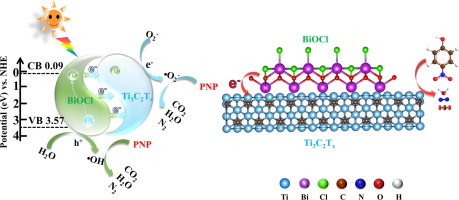当前位置:
X-MOL 学术
›
Appl. Surf. Sci.
›
论文详情
Our official English website, www.x-mol.net, welcomes your
feedback! (Note: you will need to create a separate account there.)
Self-assembled BiOCl/Ti3C2T composites with efficient photo-induced charge separation activity for photocatalytic degradation of p-nitrophenol
Applied Surface Science ( IF 6.3 ) Pub Date : 2020-07-01 , DOI: 10.1016/j.apsusc.2020.146175 Congjun Wang , Juan Shen , Rigui Chen , Fang Cao , Bo Jin
Applied Surface Science ( IF 6.3 ) Pub Date : 2020-07-01 , DOI: 10.1016/j.apsusc.2020.146175 Congjun Wang , Juan Shen , Rigui Chen , Fang Cao , Bo Jin

|
Abstract Cocatalysts play an important role in increasing the photogenerated electron-hole separation rate of catalytic materials. Here, we selected a novel 2D material Ti3C2Tx (Tx = –OH, –O) as a cocatalyst and synthesized BiOCl/Ti3C2Tx (named as BT-n n = 0, 0.5, 1.0, 2.0, 4.0) composite materials by electrostatic self-assembly. We carefully characterized the structure, morphology and photoelectric performance of the composites, finding that we successfully synthesized 2D/2D BiOCl/Ti3C2Tx materials. The photocatalytic performance of the composites was evaluated by degradation of p-nitrophenol as a pollutant under simulated illumination. Among the composites obtained, BT-2.0 showed the best photocatalytic performance; specifically, its removal rate reached 97.86% and its degradation rate was about 3.3 times that of BT-0. Free radicals in the photocatalytic process were tested by electron paramagnetic resonance, which showed that superoxide radicals and holes are the most active free radicals in the system due to the higher photogenerated electron separation efficiency of BT-2.0. Therefore, constructing a heterojunction with Ti3C2Tx as a cocatalyst can improve the photocatalytic activity of BiOCl, which may provide new insights into the selection of novel co-catalytic materials in the field of photocatalysis.
中文翻译:

自组装BiOCl/Ti3C2T复合材料具有高效的光诱导电荷分离活性,用于光催化降解对硝基苯酚
摘要 助催化剂在提高催化材料的光生电子-空穴分离率方面发挥着重要作用。在这里,我们选择了一种新型的二维材料 Ti3C2Tx(Tx = -OH,-O)作为助催化剂,并通过静电自催化合成了 BiOCl/Ti3C2Tx(命名为 BT-n n = 0, 0.5, 1.0, 2.0, 4.0)复合材料。集会。我们仔细表征了复合材料的结构、形貌和光电性能,发现我们成功合成了 2D/2D BiOCl/Ti3C2Tx 材料。通过在模拟光照下降解污染物对硝基苯酚来评估复合材料的光催化性能。在得到的复合材料中,BT-2.0表现出最好的光催化性能;具体来说,其去除率达到97.86%,降解率约为BT-0的3.3倍。通过电子顺磁共振检测光催化过程中的自由基,结果表明由于BT-2.0具有较高的光生电子分离效率,超氧自由基和空穴是体系中最活跃的自由基。因此,以Ti3C2Tx为助催化剂构建异质结可以提高BiOCl的光催化活性,这可能为光催化领域新型助催化材料的选择提供新的见解。
更新日期:2020-07-01
中文翻译:

自组装BiOCl/Ti3C2T复合材料具有高效的光诱导电荷分离活性,用于光催化降解对硝基苯酚
摘要 助催化剂在提高催化材料的光生电子-空穴分离率方面发挥着重要作用。在这里,我们选择了一种新型的二维材料 Ti3C2Tx(Tx = -OH,-O)作为助催化剂,并通过静电自催化合成了 BiOCl/Ti3C2Tx(命名为 BT-n n = 0, 0.5, 1.0, 2.0, 4.0)复合材料。集会。我们仔细表征了复合材料的结构、形貌和光电性能,发现我们成功合成了 2D/2D BiOCl/Ti3C2Tx 材料。通过在模拟光照下降解污染物对硝基苯酚来评估复合材料的光催化性能。在得到的复合材料中,BT-2.0表现出最好的光催化性能;具体来说,其去除率达到97.86%,降解率约为BT-0的3.3倍。通过电子顺磁共振检测光催化过程中的自由基,结果表明由于BT-2.0具有较高的光生电子分离效率,超氧自由基和空穴是体系中最活跃的自由基。因此,以Ti3C2Tx为助催化剂构建异质结可以提高BiOCl的光催化活性,这可能为光催化领域新型助催化材料的选择提供新的见解。











































 京公网安备 11010802027423号
京公网安备 11010802027423号